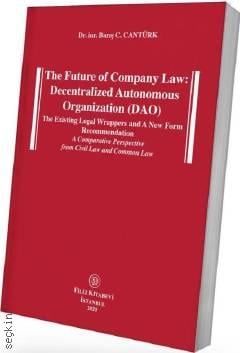>
Hukuk Kitapları>
Ticaret Hukuku>
Şirketler Hukuku>
The Future of Company Law: Decentralized Autonomous Organization (DAO)

The Future of Company Law: Decentralized Autonomous Organization (DAO)
1. Baskı,
Ekim 2025
Kitabın Detayları
Dili:
İngilizce
Ebat:
16x24
Sayfa Sayısı:
401
Kitabın Fiyatı:
950,00₺
Temin süresi 2-3 gündür.
Kitabın Açıklaması
This dissertation represents an impressive and comprehensive academic achievement that addresses very dynamic, practically important and complex challenges of contemporary company law — the legal implications and regulatory framework of Decentralized Autonomous Organizations (DAOs).
In an era where blockchain technology and decentralized systems continue to transform substantial parts of the global economic landscape, the need for legal scholarship that bridges traditional legal concepts with emerging digital innovations has never been greater. The dissertation of Mr. Cantürk is a pioneering effort in that regard, offering a thorough comparative analysis from both civil and common law perspectives while also presenting forward-thinking regulatory proposals.
Kitapla İlgili Kategoriler
Kitabın İçindekileri
TABLE OF CONTENTS
FOREWORD
V
2nd PREFACE
VII
1st PREFACE
IX
TABLE OF CONTENTS
XI
ABBREVIATIONS
XVII
ABSTRACT
XXIII
ZUSAMMENFASSUNG
XXIII
SCOPE
1
CHAPTER I:
INTRODUCTION to BLOCKCHAIN
I. BASICS of BLOCKCHAIN
9
1. History and Definition
9
2. Technology
13
3. Advantages and Disadvantages
15
4. Related Terms
17
4.1. Distributed Ledger Technology
17
4.2. Oracle
19
4.3. Crypto–asset
20
4.4. Ethereum
23
4.5. Smart Contract
24
4.6. Decentralized Autonomous Organization
27
4.7. Initial Coin Offering
28
II. LEGAL DEVELOPMENTS
29
1. Civil Law Jurisdictions
30
1.1. Germany
30
1.2. Türkiye
32
1.3. Switzerland
33
2. European Union
35
3. Common Law Jurisdictions
39
3.1. United Kingdom
39
3.2. United States
40
4. Notable Examples around the World
42
III. FUNDAMENTAL NOTIONS related to DAO and THEIR LEGAL NATURE
44
1. Introduction
44
2. Crypto–asset
45
2.1. Introduction
45
2.2. Definition, Related Terms and Differences
45
2.3. Legal Analyses
47
2.3.1. Introduction
47
2.3.2. Civil Law Jurisdictions
48
2.3.2.1. German Law
48
2.3.2.1.1. Classification as Property
49
2.3.2.1.2. Classification as Money
53
2.3.2.1.3. Classification as Financial Mediums
55
2.3.2.1.4. Classification as Intellectual Property Rights
59
2.3.2.2. Turkish Law
60
2.3.3. European Union Law
63
2.3.4. Common Law Jurisdictions
66
2.3.4.1. United Kingdom
66
2.3.4.2. United States
68
2.3.5. Interim Result
70
3. Smart Contract
73
3.1. Definition, Legal Analyses and Regulatory Aspects
74
3.2. Legal Capacity
80
3.3. Offer and Acceptance
83
3.4. Language and Format
88
3.5. Execution and Termination
91
IV. INTERIM CONCLUSION
95
CHAPTER II:
THE EXISTING LEGAL WRAPPERS Application of the Existing Legal Wrappers to DAO
I. BASICS of DAO
109
1. Introduction
109
2. Definition throughout Historical Trajectory
110
3. Features of DAO
114
4. Taxonomies and Market Practice
116
II. CURRENT LEGAL DEVELOPMENTS
119
1. Civil Law Jurisdictions
119
2. Common Law Jurisdictions
120
3. Notable Examples around the World
122
III. GENERAL LEGAL REVIEWS on DAO
123
1. Introduction
123
2. Legal Nature
125
3. Liability
129
4. Bodies and Their Relations
132
IV. APPLICATION of THE EXISTING LEGAL WRAPPERS to DAO
134
1. Introduction
134
2. Partnership
135
2.1. Introduction
135
2.2. Civil Law Jurisdictions
136
2.2.1. Ordinary Partnership (Adi Ortaklık / Gesellschaft bürgerlichen Rechts)
136
2.2.1.1. Legal Nature and Liability
137
2.2.1.2. Establishment
144
2.2.1.3. Mandatory Bodies
151
2.2.1.4. Relationships
153
2.2.1.5. Dissolution of Partner Status and Partnership
159
2.2.2. Other Forms
165
2.2.3. Interim Result
165
2.3. Common Law Jurisdictions
167
2.3.1. Introduction
167
2.3.2. General Partnership
168
2.3.3. Limited Partnership and Sister Forms
171
2.3.3.1. Limited Partnership
171
2.3.3.2. Limited Liability Partnership
174
2.3.4. Unincorporated (Non–Profit) Association
175
2.3.5. Interim Result
177
3. Corporation
177
3.1. Introduction
178
3.2. Civil Law Jurisdictions
179
3.2.1. Introduction
179
3.2.2. Joint Stock Company (Anonim Ortaklık / Aktiengesellschaft)
179
3.2.2.1. Legal Nature and Liability
181
3.2.2.2. Establishment
183
3.2.2.2.1. Basics of Establishment Process and Articles of Association
183
3.2.2.2.2. Capital
185
3.2.2.3. Mandatory Bodies
189
3.2.2.3.1. Introduction
189
3.2.2.3.2. Management Board
189
3.2.2.3.3. General Assembly
191
3.2.2.3.4. Supervisory Board
194
3.2.2.4. Share and Shareholders
195
3.2.2.4.1. Introduction
196
3.2.2.4.2. Rights and Obligations
198
3.2.2.4.3. Voting Rights
200
3.2.2.4.4. Shareholder Decision–Making
202
3.2.2.5. Audit
204
3.2.2.6. Dissolution and Termination
205
3.2.2.7. Interim Result
206
3.2.3. Limited Company (Limited Şirket / Gesellschaft mit beschränkter Haftung)
207
3.2.3.1. Legal Nature and Liability
208
3.2.3.2. Establishment
209
3.2.3.2.1. Basics of Establishment Process and Articles of Association
210
3.2.3.2.2. Capital
211
3.2.3.3. Bodies
212
3.2.3.3.1. Introduction
212
3.2.3.3.2. Directors
212
3.2.3.3.3. Shareholders Meeting
213
3.2.3.4. Share and Shareholders
215
3.2.3.4.1. Rights and Obligations
215
3.2.3.4.2. Share Transfer
217
3.2.3.5. Audit
218
3.2.3.6. Dissolution and Termination
219
3.2.3.7. Interim Result
220
3.3. Common Law Jurisdictions
221
3.3.1. Introduction
221
3.3.2. Public Limited Company / Corporation
222
3.3.3. Private Limited Company / Limited Liability Company
223
V. NEW LEGAL WRAPPERS TAILORED for DAO
225
1. Introduction
225
2. Vermont
226
3. Wyoming – Tennessee – Marshall Islands
227
4. Utah
232
5. Delaware
236
6. Model Law
237
VI. INTERIM CONCLUSION
239
CHAPTER III:
THE NEW CODE A New Form Recommendation for DAO
I. INTRODUCTION
269
II. THE NEW CODE
272
III. INTERIM CONCLUSION
321
CONCLUSION
331
BIBLIOGRAPHY
359
CURRICULUM VITAE
377
Kitabın Fiyatı:
950,00₺
Temin süresi 2-3 gündür.
Bu kitaplar da ilginizi çekebilir
Hakkımızda
|
Uluslararası Yayınevi Belgesi|
Kaynakça Dosyası|
Kişisel Verilerin Korunması |
Üyelik|
Siparişlerim|
İade Politikası|
İletişim


